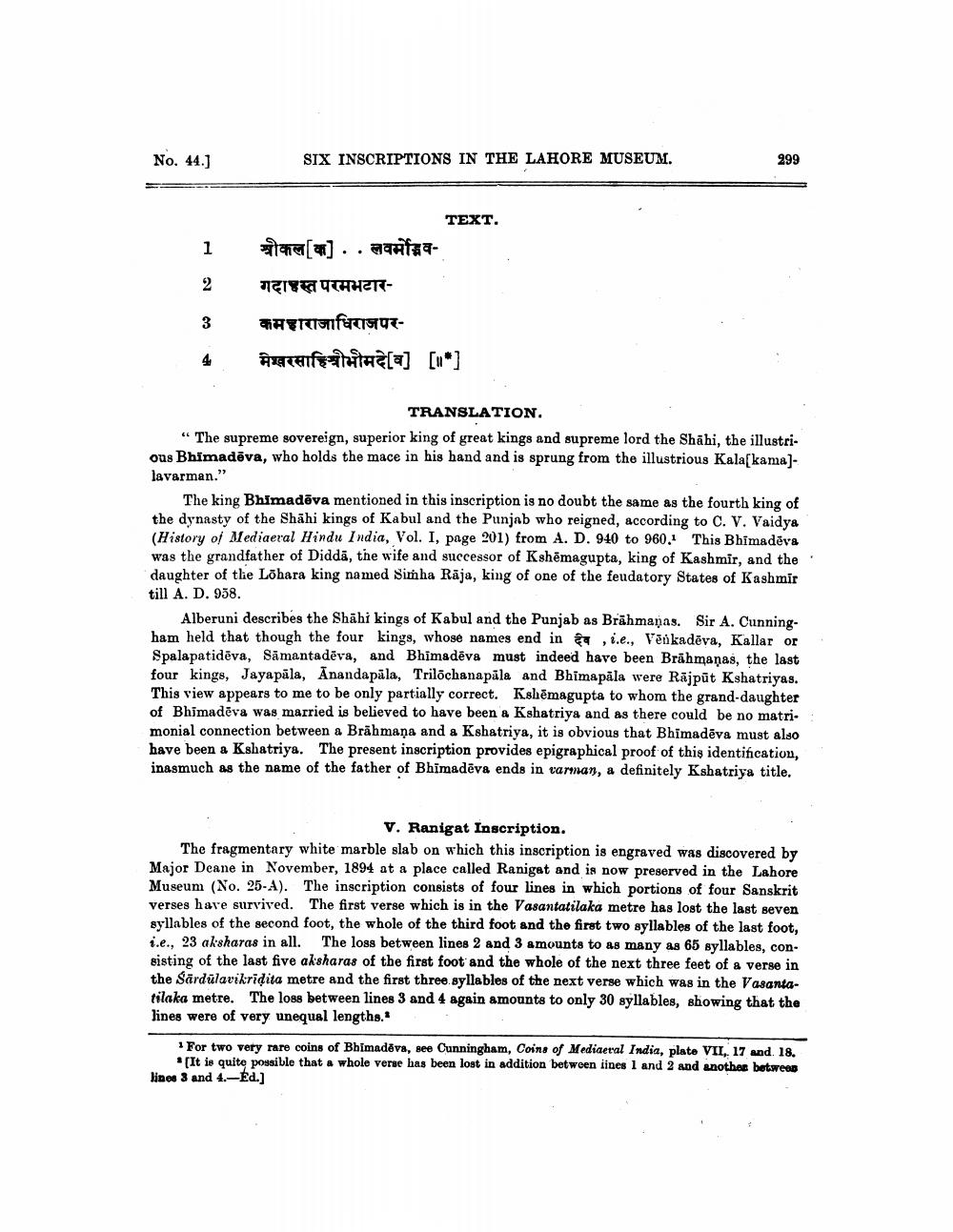________________
No. 44.]
1
2
3
4
SIX INSCRIPTIONS IN THE LAHORE MUSEUM.
चोकल [क] लयर्मोव
गदाहस्त परमभटार
• •
TEXT.
कमहाराजाधिराजपर
मेम्वरसाहिश्रोभोमदे[व] [*]
299
TRANSLATION.
"The supreme sovereign, superior king of great kings and supreme lord the Shahi, the illustrious Bhimadeva, who holds the mace in his hand and is sprung from the illustrious Kala[kama]
lavarman."
The king Bhimadeva mentioned in this inscription is no doubt the same as the fourth king of the dynasty of the Shahi kings of Kabul and the Punjab who reigned, according to C. V. Vaidya (History of Mediaeval Hindu India, Vol. I, page 201) from A. D. 940 to 960. This Bhimadeva was the grandfather of Didda, the wife and successor of Kshēmagupta, king of Kashmir, and the daughter of the Lohara king named Simha Raja, king of one of the feudatory States of Kashmir till A. D. 958.
Alberuni describes the Shahi kings of Kabul and the Punjab as Brahmanas. Sir A. Cunningham held that though the four kings, whose names end in, i.e., Venkadeva, Kallar or Spalapatidēva, Samantadeva, and Bhimadēva must indeed have been Brahmanas, the last four kings, Jayapala, Anandapala, Trilochanapala and Bhimapala were Rajput Kshatriyas. This view appears to me to be only partially correct. Kshēmagupta to whom the grand-daughter of Bhimadeva was married is believed to have been a Kshatriya and as there could be no matrimonial connection between a Brahmana and a Kshatriya, it is obvious that Bhimadeva must also have been a Kshatriya. The present inscription provides epigraphical proof of this identification, inasmuch as the name of the father of Bhimadeva ends in varman, a definitely Kshatriya title.
V. Ranigat Inscription.
The fragmentary white marble slab on which this inscription is engraved was discovered by Major Deane in November, 1894 at a place called Ranigst and is now preserved in the Lahore Museum (No. 25-A). The inscription consists of four lines in which portions of four Sanskrit verses have survived. The first verse which is in the Vasantatilaka metre has lost the last seven syllables of the second foot, the whole of the third foot and the first two syllables of the last foot, i.e., 23 aksharas in all. The loss between lines 2 and 3 amounts to as many as 65 syllables, consisting of the last five aksharas of the first foot and the whole of the next three feet of a verse in the Sardulavikriḍita metre and the first three syllables of the next verse which was in the Vasantatilaka metre. The loss between lines 3 and 4 again amounts to only 30 syllables, showing that the lines were of very unequal lengths.
1 For two very rare coins of Bhimadeva, see Cunningham, Coins of Mediaeval India, plate VII, 17 and 18. [It is quite possible that a whole verse has been lost in addition between iines 1 and 2 and another between lines 3 and 4.-Ed.]




